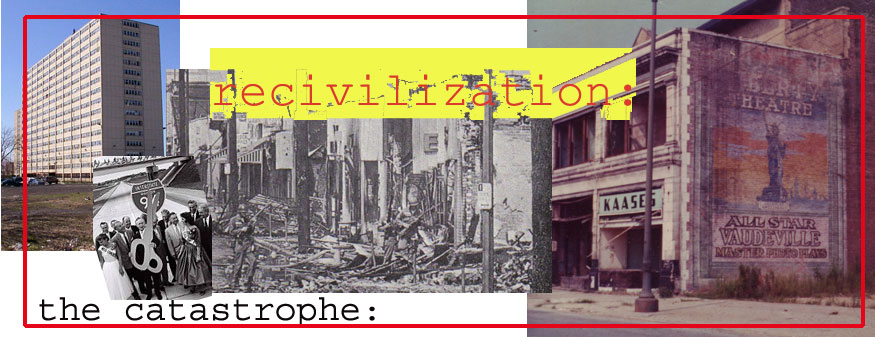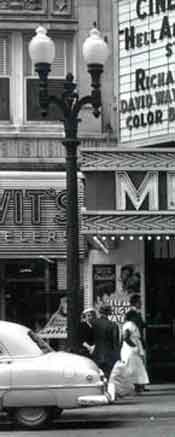

303 prelude, v-j day
At the end of wartime rationing and rent control, cities were bursting at the seams. Before gas rationing ended, bus and streetcar ridership came back up almost to 1920 levels. Blackouts were over, and downtown the lights never seemed brighter. Everyone remarked at the crowds; people had lots of money in their pockets, and they were out on the street taking care of business, practical and sentimental, that they'd had to put off for years. Our city was brash and strange, but it looked good. It had begun its store of essential images with painters: John Sloan, Childe Hassam and Edward Hopper, now joined by photographers like Weegee and Walker Evans. Radio was never more entrancing; you could spin the dial and hear the music of the city that had found its voice, from Duke Ellington's band to Woody Herman's, from odd new strains of bop doodling out of 52nd Street to juke-joint rhythm and blues from Detroit and Chicago, to steel guitar-driven Texas swing, 'on remote' from clubs in Tulsa and Dallas. In between the music and the Lone Ranger and the Green Hornet and the Lucky Strike ads you would hear voices discussing public affairs on a level that seems a world away: a white union man prophesying the end of segregation, a real estate man calling for more planning, or the head of the U. S. Chamber of Commerce insisting on the need for business to cooperate with the federal government to build the bright, fair postwar world to come. It was a Wonderful Life; this was Frank Capra's America, and after the trials of depression and war, the land of the free had never looked finer to the world, or to itself. In its postwar innocence, and confidence, the nation was ready to go out and rebuild a frazzled planet, and right every wrong it could find at home. As fate would have it, we were instead on the eve of our greatest domestic calamity since the Civil War. We can see part of the background to the collapse in the events of the 20's and 30's: the creation of monolithic black ghettos, the beginnings of federal intervention and the technocratic ideologies of architects and planners. With hindsight, we may also consider the effect of the Depression on the previously booming industrial towns of the northeast. After that blow, the war only postponed the inevitable decline of heavy industries past their peak. Depression and war had left cities with high tax rates and plenty of debt. For the neighborhoods, their legacy was a decade and a half of deferred restoration and maintenance. Many older neighborhoods declined dangerously, and large numbers of old houses were subdivided, important factors contributing to postwar decay and abandonment. The decade and a half of pent-up demand to move outwards and upwards exploded as soon as circumstances permitted, aggravating the effects. Another gift of the Depression, at least in the Northeast and Midwest, was the excessive timidity shown by political and business leaders after the war. In Cleveland they called it 'Depression psychosis', but it was the same in Chicago. The city that had always told itself it was destined to be the metropolis of the planet now curled up and licked its wounds and wondered what would happen to it next. In 1950, A. J. Liebling found Chicago with 'the personality of a man brought up in expectation of a legacy who has learned in middle age that it will never be his'. Having been overextended and burned once, a generation of bankers and businessmen weren't about to let it happen again. Worst of all, the threats of the postwar world caught cities at a time when they were politically at their weakest. In the first half of the century they had won some new strengths: more efficient and effective governments, new legal powers for planning and redevelopment, and courts and legislatures that were becoming steadily more willing to support their undertakings. All these advantages, however, were more than outweighed by the strange new circumstances of governance. Now, much of the power and initiative they once held had gone to Washington. And at home, imperceptibly, a ring of incorporated suburbs had frozen around the city, blocking its natural expansion. An average city might have authority over slightly more than half of its population, as in Chicago or Atlanta. In Pittsburgh, it was only a third. Worse, this new artificial boundary corresponded to and confirmed a class division. The 'inner city', as it came to be called, comprised the center, the slums, declining and soon-to-be declining industrial areas, and a good many neighborhoods on the edge where the middle-class population was drifting away. All the new industrial and commercial districts, along with residential growth areas, were in the suburbs. The original body of the city, increasingly distressed, had to contend with all the problems. In the new neighborhoods, safe behind their artificial boundaries, people could convince themselves that the problems had nothing to do with them. Academia has hardly been shy to account for the ruin of the cities, but its conclusions tell only a part of the story. A summary of the general theories might look like this: 1. The socio-technological explanation, blaming most of the mess on the car, along with the Jeffersonian urge to the single-house lot, and its ancient connotations of self-sufficiency. The 'city' (i. e. the center and the neighborhoods left behind) comes to be seen as the natural home of vice and violence, congestion and social ills. This approach admits no malign intent by the decision makers, only the logic of using new technologies to meet desires; the market is impersonal and valueless. 2) For some leftist thinkers, it was all about capitalist accumulation, which required cities to be entirely restructured over and over for the commercial, industrial and corporate eras; the capitalists adopted a 'slash and burn' method of creating the labor communities they required, finding the profitable and easy creation of new communities better than the difficult task of maintaining old ones. Suburbanization is seen as a corporate strategy to relocate labor and business to places where there is cheap land and good transport, along with contented, non-unionized workers and low taxes. Meanwhile what's left behind is useless and doomed to disappear, eventually fit only for clearing to await capital's future uses for it. 3) The consensus of conservatives, which tends to ignore or downplay all these structural problems, finding the answer instead in the moral corruption and disastrous policies of the liberals who dominated both national and inner-city governments in the period. Their ascendancy led to a breakdown of morals and civil behavior, hastening the flight of the middle class. While the owners and manipulators of capital may have made any number of decisions that harmed cities, no one conspired consciously to ruin them, and no vicious economic determinism ordained it must happen. Modern historians rarely consider the element of sheer human folly, expressed in all-encompassing ideologies and dogmas, misunderstandings, bigotry and the unintended consequences of aggressive public policy. It can be a salutary lesson to look at a period in which a well-intentioned and confident nation, convinced it knew all the answers, strove forthrightly and expensively to get out of the mud, and instead drove itself right into quicksand. Studying the postwar decades can prove just as disorienting as was living through them. In retrospect one gets the impression of a nation in a trance, continuing on a disastrous course when all the evidence at hand should have suggested a correction. The collapse of the cities was a breakdown of American thought, a fiasco of democratic governance. We cannot study it enough; we cannot think about it enough. |
|

|